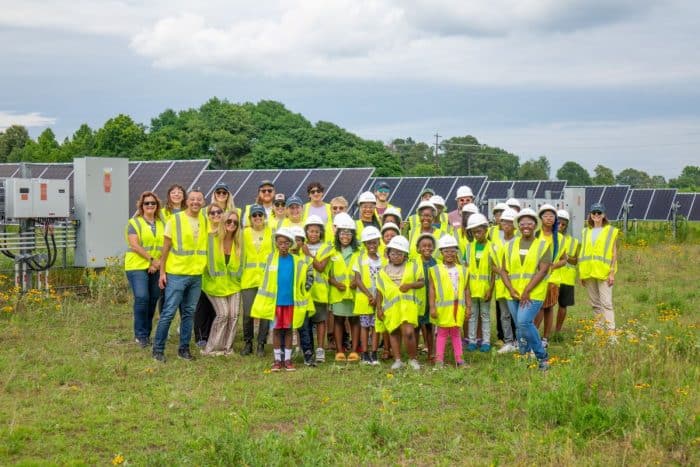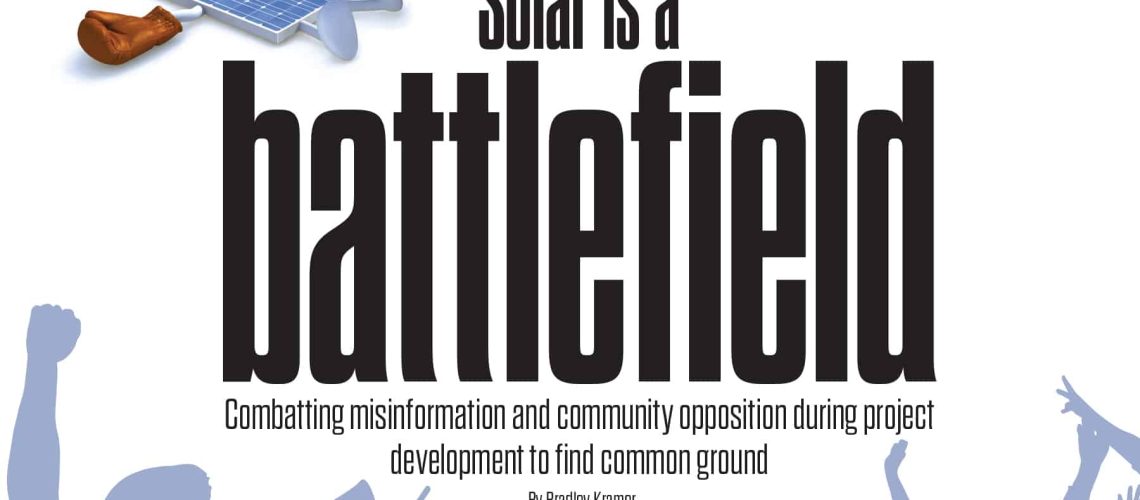A proposed 100 MW solar farm proposed by RWE Clean Energy in Prince George County, Virginia, draws opposition from residents who say it will hurt their quality of life and threaten the future for local farmers and hunters.
Residents of Moscow, Maine, vote to ban commercial solar projects, joining a growing list of municipalities in the state to limit or prohibit large solar farms.
An anonymously funded group spreads misinformation about the 120 MW Frasier Solar project in Knox County, Ohio.
Activists in Klickitat County, Washington, have fiercely resisted solar energy for years, leading to two of the county’s three commissioners approving a temporary ban on new commercial-sized solar developments.
Large-scale solar projects have seen growing opposition from locals crying NIMBY — or Not In My Back Yard. However, there are some best practices that developers can follow to help circumvent these challenges and generate local support for their initiatives.
A big catalyst for solar NIMBY-ism stems from a lack of understanding about certain projects, according to Gina Brown, senior director of economic development and community engagement at Silicon Ranch.
“We hear different arguments from the opposition, but at the core there’s a lot of misinformation out there,” she says. “It’s about how do we combat the opposition in a timely manner, and how do we get in front of that challenge. There’s a lot of NIMBY-ism is some areas. When we get into different areas, we try to be as transparent as possible about what the project is going to look like, what kind of screening will be used and things like that, and we try to make sure the local residents know they have a contact at Silicon Ranch that they can filter questions to and get an answer.”
As one of the first 100 employees hired by the Nashville-based solar project developer, owner and operator, Brown has seen a lot of growth in the industry, and that has had a direct impact on the growth in opposition. And the basis of that opposition can depend on where in the United States the project is situated. For instance, some of the strongest opposition Brown has seen is from projects in the U.S. Southeast, especially in terms of land use.
“They tend to have concerns about what the project is going to look like and whether solar is the best use of certain land right now,” she says. “Solar projects are very specific in where they need to be located. It’s important for developers to work with the community and explain why this land is the best location for a solar project. All that is to say, the earlier the better.”
Brown says that larger projects garner the most opposition because of the amount of land they require.
“At Silicon Ranch, we own our land. A lot of people appreciate that, for fear of flipping,” Brown says. “When they hear 6,000 acres being taken up, that’s daunting for some people. It’s important for us to say it’s not 6,000 acres of solar panels. Our belief is that we’re taking that land into a rest period. After the project’s life cycle, we are returning the land to the same or better condition than how we found it.”
Policy to push solar
Echoing Brown’s sentiments about the growth of solar opposition mirroring the growth of solar development, Caitlin Connelly, research associate for distributed solar at Wood Mackenzie, says more opposition to solar development is found in states where projects are more visible.
“The more saturated states tend to have more vocal opposition,” Connelly says. “The projects are more visible and so they get more pushback.”
A lack of trust can be a major factor in the lack of community support.
“It can be difficult for developers to get subscribers for a solar project and getting that trust built,” Connelly says. “In the Northeast market, where some people don’t trust solar, companies are not getting buy-in. Historically, they have had problems with canvassing scams, so they don’t trust solar. That’s where you see subscription acquisition companies coming in to build trust and reduce the amount of churn that’s important for long-term financial success.”
Connelly adds that some of the opposition comes from siting policies and easement acquisition rules that can stymie solar projects. That’s where lobbying efforts can help improve regulations and incentivize solar development.
“Policy-based solutions can drive more expansion by incentivizing the brownfield development and agrivoltaics,” she says. “State policy can be developed to incentivize companies to build on sites that people wanted developed.”
Brown offers four tips to improve community engagement:
- Understand the community — Researching the location is important. You have to do the leg work prior to making a phone call.
- Make contact — Ensure that those who live near the project are notified and have a touch point as early as possible to start talking about the project.
- Never too much information — When working with a community, make sure the local leaders know what they are approving.
- Be human — This may be a lofty goal, but meet people where they are and listen to their concerns.
“No one wants to feel like they don’t know what’s happening in their own backyard,” Brown says. “If they have a lifeline to talk to, then that matters to them. Send a postcard, then follow up and knock on their door. Make a real connection.”
While Brown adheres to her best practices, she’s quick to note that there’s no catch-all solution to developing solar projects.
“Sometimes I wish projects were more formulaic, but one thing I enjoy about the job, even with some of the opposition we face in the industry as a whole, is that no project is exactly the same, because you’re always dealing with different people.”

Meet them where they are
Getting out into a community is a key factor in establishing understanding, Brown says, both in terms of the developer understanding their chosen jobsite and for the locals to understand the project.
“As a business developer, if we go into a former coal community, we have to understand they might have a different view on renewable energy that goes way back and hits a different place for them,” Brown says. “There might be a sense of renewable energy is taking those jobs. We have to respect that.”
Instead of a developer coming in and pushing the merits of clean energy, Brown suggests highlighting the value of the project, the jobs it will create and what it will mean to the community.
Another big hurdle for solar developers is the spread of misinformation.
“The amount of misinformation that opponents are able to channel around is due to social media,” Browns says. “We’ve all seen how the game of telephone gets played. It doesn’t matter if it’s about renewable energy or politics, it’s harder than ever to control the message. That’s why it’s even more important to get on the jobsite to explain the importance of the project and reasons behind it.”
Brown harkens back to her message on the importance of early communication in the battle against false information.
“There’s a misconception that installing solar panels into the ground is dangerous,” Brown says. “There are people who like to hop on the bandwagon of contamination and other environmental impacts. Through our studies, they can see we are taking care of the land. Whether it’s farm land or timber land, we’re taking care of the land they respect, and we’re not going to turn it into something that will harm the land in the future.”
Being human
In the end, building community support is all about trust and communication.
“We have to make sure we’re walking the walk when we set up shop in a community,” Brown says. “We have to let people know what is the benefit of the solar industry. Face it, everyone wants to know what’s in it for me.”
One of the most important factors for garnering community support for solar projects might sound simple.
“Be human,” Brown says. “That sounds really generic and easy, but it’s important to have conversations and meet people where they are. I like the strategy we take. We don’t want to go into a community with the project first, but instead let them know who we are and that we want to be a long-term corporate neighbor, and this is why, this is how and this is when. The earlier you are able to go in and meet people from a conversation level, the better you are able to understand what is going on in their community and what are the things that matter most to them. That’s the best way to go about engagement and partnering with the community, because ultimately it does become a partnership.”
Brown’s approach to community engagement is to “dive deeper into really understanding the community” by setting up meetings and making sure to make that connection.
“If we just go in with structure designs and blueprints, we’re setting ourselves up to not connect,” she says.
Brown notes that she didn’t come into the solar industry with a project development background, but she has learned an important lesson in the three years she has been involved in the industry: “The work we do on the community engagement side is not rocket science. We’re people trying to connect with people.”
Brad Kramer is managing editor of Solar Builder.



